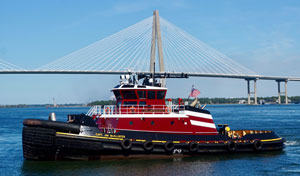For most tugboat companies, building one new azimuthing stern drive (ASD) tugboat would make for a pretty good year. McAllister Towing and Transportation added two within just eight months.
The 6,772-hp Capt. Jim McAllister left Eastern Shipbuilding in late August 2019, arriving soon afterward in Charleston, S.C. The 100-foot vessel routinely escorts and assists post-Panamax containerships calling on the sprawling Wando Welch Terminal across the Cooper River in Mt. Pleasant, S.C.
Eileen McAllister, a 93-foot, 6,772-hp, ship docking and escort tugboat built at Washburn & Doughty, provides similar services in Port Everglades, Fla. McAllister paired Eileen with Tate McAllister, built six years ago with the same hull but different propulsion and winch packages.
Both new tugs are powered by brawny Caterpillar 3516 Tier 4 engines paired with Schottel z-drives. Capt. Jim delivers 82.5 metric tons of bollard pull, which is roughly equal to the 93 short tons Eileen generates. Both are the most powerful ship-assist tugboats working in their respective ports.
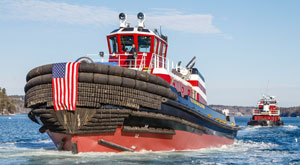 |
|
Eileen McAllister, launched earlier this year from Washburn & Doughty Shipyard, was christened by Eileen Buch, Eileen Duane Donovan and Eileen Fitzsimons, three direct decendants of company founder James McAllister. |
“In the past, we have seen up to 1,000-foot containerships,” said Capt. Chuck Runnion, McAllister’s general manager and vice president in Port Everglades. “And with the Eileen we are handling these 1,000-footers with the greatest of ease.”
McAllister’s tugboat crews in Charleston are similarly upbeat about Capt. Jim. It is the final tugboat in a four-vessel order, and the only one of the bunch to leave the shipyard with a Coast Guard certificate of inspection under Subchapter M.
“It’s hard to impress me at this point, but that boat floored me,” said Capt. Steve Kicklighter, a McAllister vice president and Charleston general manager. “It has the most environmentally friendly diesel engines, and the accommodations spaces for the crew are unsurpassed.”
“Without a doubt,” he added, “this is the best of all four.
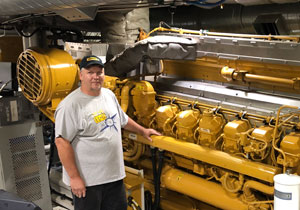 |
|
Capt. Jim engineer Michael Cobb stands alongside one of two Cat 3516E units delivering 3,386 hp each. |
McAllister announced the four-tug series of ship assist and escort tugs in early 2016, becoming one of the first operators with a multiboat Tier 4 order. Horizon Shipbuilding won the contract and built the lead boat, Capt. Brian A. McAllister, before running into financial trouble and ultimately declaring bankruptcy in late 2017.
Eastern Shipbuilding of Panama City, Fla., finished construction on Rosemary McAllister and Ava McAllister, the second and third vessels in the series, which arrived at the shipyard in varying stages of completion. Eastern built Capt. Jim McAllister from the keel up, a point that Kicklighter said makes the tug stand out. Capt. Brian and Ava work in New York, McAllister’s headquarters, while Rosemary is based in Norfolk, Va.
The four boats are designed for escorting and docking ultra-large container vessels now calling on major East Coast ports. Jensen Maritime Consultants of Seattle, a longtime McAllister partner, designed the 100-by-40-foot hull. It features a modest skeg, but relies heavily on its wide beam for effective high-speed escorts.
Propulsion also is the same across the 100-foot series. All four are powered by twin Cat 3516 engines each delivering 3,386 hp at 1,800 rpm. Straight carbon-fiber shafts connect the mains to Schottel z-drives turning 110-inch nibral props encased in nozzles. Three Cat C7.1 generators provide ship service power.
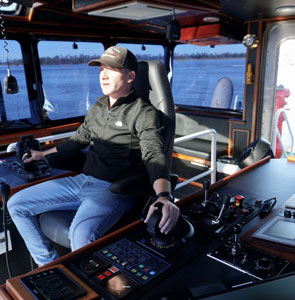 |
|
Mate Josh Kicklighter steers Capt. Jim into McAllister’s North Charleston dock during the late afternoon sun. |
The tugs have tankage for 2,500 gallons of diesel exhaust fluid needed to meet EPA Tier 4 emissions rules. The urea and water mixture injected into the exhaust stream is kept in climate-controlled spaces to prevent degradation. The engineering control panels also are segregated from the main engine space, providing a quieter and more comfortable working environment for the engineer.
Capt. Jim, like Ava McAllister before it, is outfitted with a 75-hp Markey hawser winch and a single-drum towing winch on the stern. Firefighting consists of two 1,500-gpm FFS monitors fed by a 3,000-gpm fire pump driven by a Cat C9.3 engine.
Josh Kicklighter, the mate on Capt. Jim McAllister alongside his brother, Capt. Matt Kicklighter, considers the Markey hawser winch a good match for the tug. He likened good winches on powerful tugs to top-quality tires on a sports car: They complete the package to deliver superior performance.
“The winches they put on here, they are light-years above some of the stuff I have used in the past,” he said, adding that he has come to trust the winch completely.
Josh Kicklighter demonstrated Capt. Jim’s abilities on a sunny, clear fall day in Charleston. Capt. Jim easily pulled the bow of the 462-foot Bochem Singapura off Kinder Morgan Berth 4, then spun the tanker 180 degrees for departure. An hour later, again paired with the 5,000-hp Moira McAllister, Capt. Jim backed the 656-foot vehicle carrier Toledo off the Columbus Street Terminal. The tug used no more than half power for both jobs.
“But when you want the power, it’s there,” Kicklighter said. “When you put rubber to steel and start pushing stuff around, you can see it does what it is supposed to do.”
McAllister crews in Fort Lauderdale feel the same way about Eileen McAllister, which arrived in early April. Port Everglades is undergoing extensive upgrades to facilitate calls from larger containerships. Post-Panamax cranes should arrive around Christmastime, and the main container port is adding 3,900 feet of dock space. Dredging also is in the works.
Getting post-Panamax ships safely in and out of these berths will require some muscular tugboats. Capt. Todd Cooper, co-managing pilot of the Port Everglades Pilots Association, described a challenging entry into the port requiring a high-speed tethered escort preceding a 110-degree turn into the Intracoastal Waterway. The waterway shrinks to 390 feet at its narrowest point.
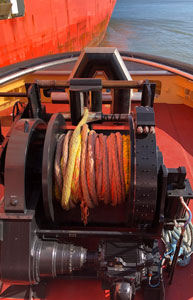 |
|
Markey Machinery supplied the DEPC-42 stern winch and single-drum DEPCF-52 hawser winch shown on Capt. Jim’s bow. |
Eileen McAllister, Cooper said, is the right size and has plenty of power to handle large ships in tight spaces. “What it is going to do is allow us and Port Everglades to ramp up and allow bigger ships into the port, especially with the port expansion projects we have going on,” he said.
Runnion, McAllister’s general manager in Port Everglades, said Washburn & Doughty’s 93-foot hull makes the tug a good fit for the confined harbor. The design has proven itself repeatedly over the years for Moran Towing, Marine Towing of Tampa and Harbor Docking & Towing, among others. The tugs, in short, are stable during escorts but plenty maneuverable when docking ships.
“The reason we like that brand of boat, the Washburn & Doughty boat, is because they are shorter and they can fit into the tanker slips,” Runnion said. “The tug captains like the Washburn & Doughty hulls … because they seem to maneuver well either way, going ahead or astern, and you don’t have to muscle it around.”
Eileen shares the same 93-by-38-foot design as Tate McAllister but has a host of upgraded components. Tier 4 Cat 3516s replaced EMD Tier 3 engines, adding about 772 horsepower. Bollard pull jumped from 79 to 93 short tons. Eileen’s Cat engines turn Schottel SRP 490 FP z-drives, and a Cat C18 engine drives a fire pump that supplies a single 6,000-gpm FFS monitor with foam injection capability.
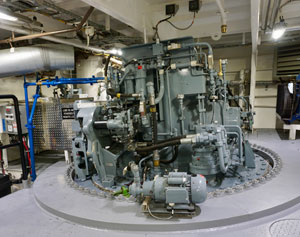 |
|
The tug is outfitted with Schottel SRP 4000 FP z-drives. |
The winch package also changed. Eileen has the same Markey DEPCF-52 winch on the bow as Capt. Jim with 600 feet of 8.5-inch Cortland Plasma LoCo rope. The Markey DEPC-42 tow winch installed on the aft deck is spooled with 450 feet of 2.25-inch Samson AmSteel-Blue. Tate McAllister, meanwhile, has JonRie winches forward and aft.
“With the Eileen and Tate McAllister, we will be able to handle anything that comes into Port Everglades,” Runnion said.
Eileen and Capt. Jim typically operate with four crew. Both have four cabins, along with a full galley and mess, giving each person their own room under typical conditions. Eileen has three heads, something Runnion said he insisted on during the design phase. “The tug is designed for comfort, which leads to crew retention,” he said.
Martin Costa, McAllister’s engineering manager who helps oversee new construction, suggested the company will take a break from new construction after a busy few years. “I think we’ll take a breather,” he said. “Five boats is a lot to get done in four years."

